Taxation Law: Analysis of Partnership and Fringe Benefits in Australia
VerifiedAdded on 2023/04/21
|11
|1890
|213
Report
AI Summary
This report provides a detailed analysis of Australian taxation law, focusing on two key areas: partnership taxation and fringe benefits. The first part examines the tax implications for partnerships, including how profits are distributed and taxed, relevant sections of the Income Tax Assessment Act 1997 (ITAA 1997), and allowable deductions. It analyzes a case study involving a mixed business partnership, considering ordinary income, capital expenses, and the application of tax rulings. The second part of the report delves into fringe benefits tax (FBT), exploring the tax treatment of benefits provided by employers to employees. It covers scenarios such as employee contributions, payments for an employee's child's schooling, and the provision of accommodation, referencing the FBT Assessment Act 1986. The report discusses the nexus between the benefit and the employee, the valuation of fringe benefits, and the reduction of FBT liability through employee contributions. It concludes with a comprehensive reference list of relevant sources.
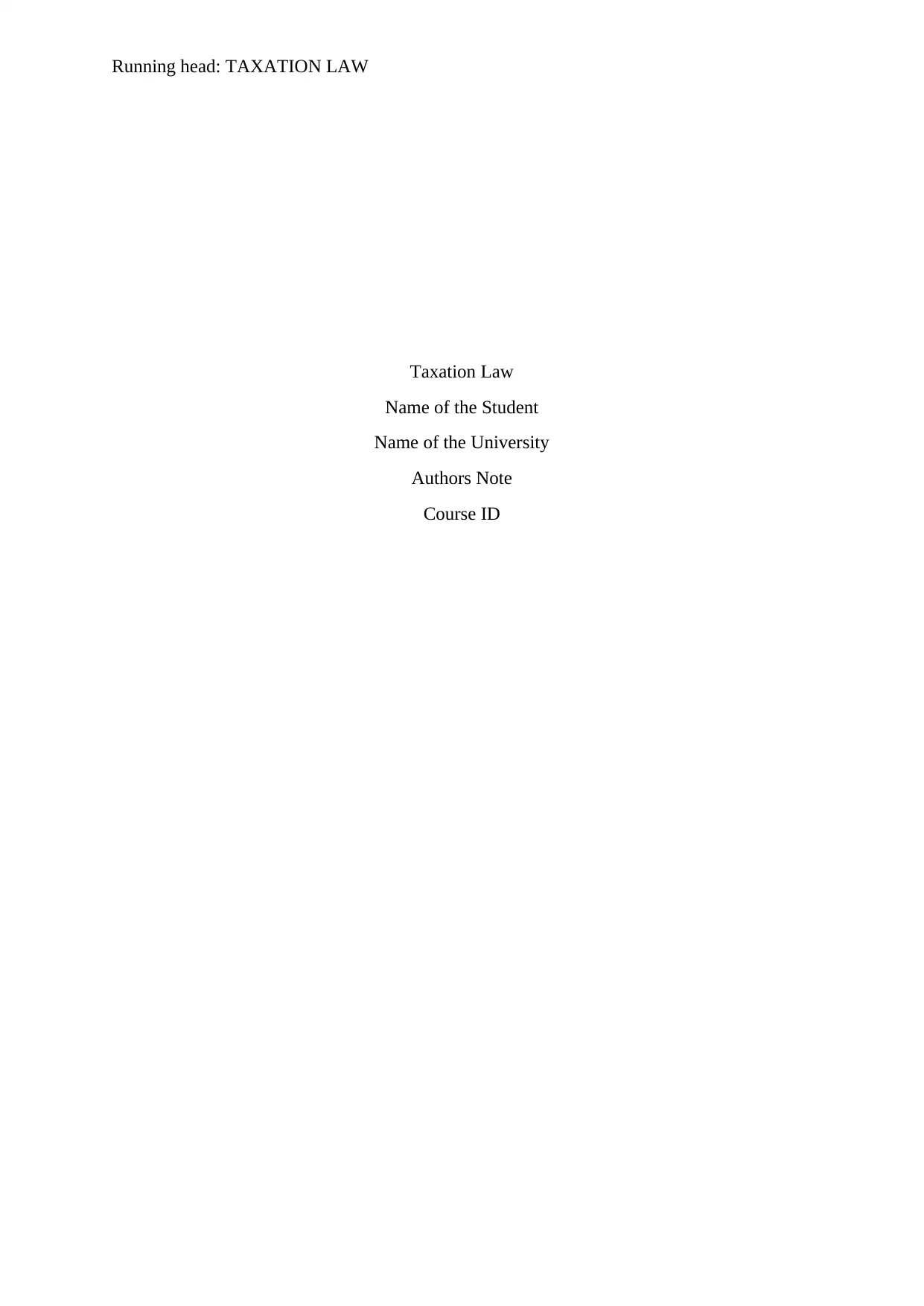
Running head: TAXATION LAW
Taxation Law
Name of the Student
Name of the University
Authors Note
Course ID
Taxation Law
Name of the Student
Name of the University
Authors Note
Course ID
Paraphrase This Document
Need a fresh take? Get an instant paraphrase of this document with our AI Paraphraser
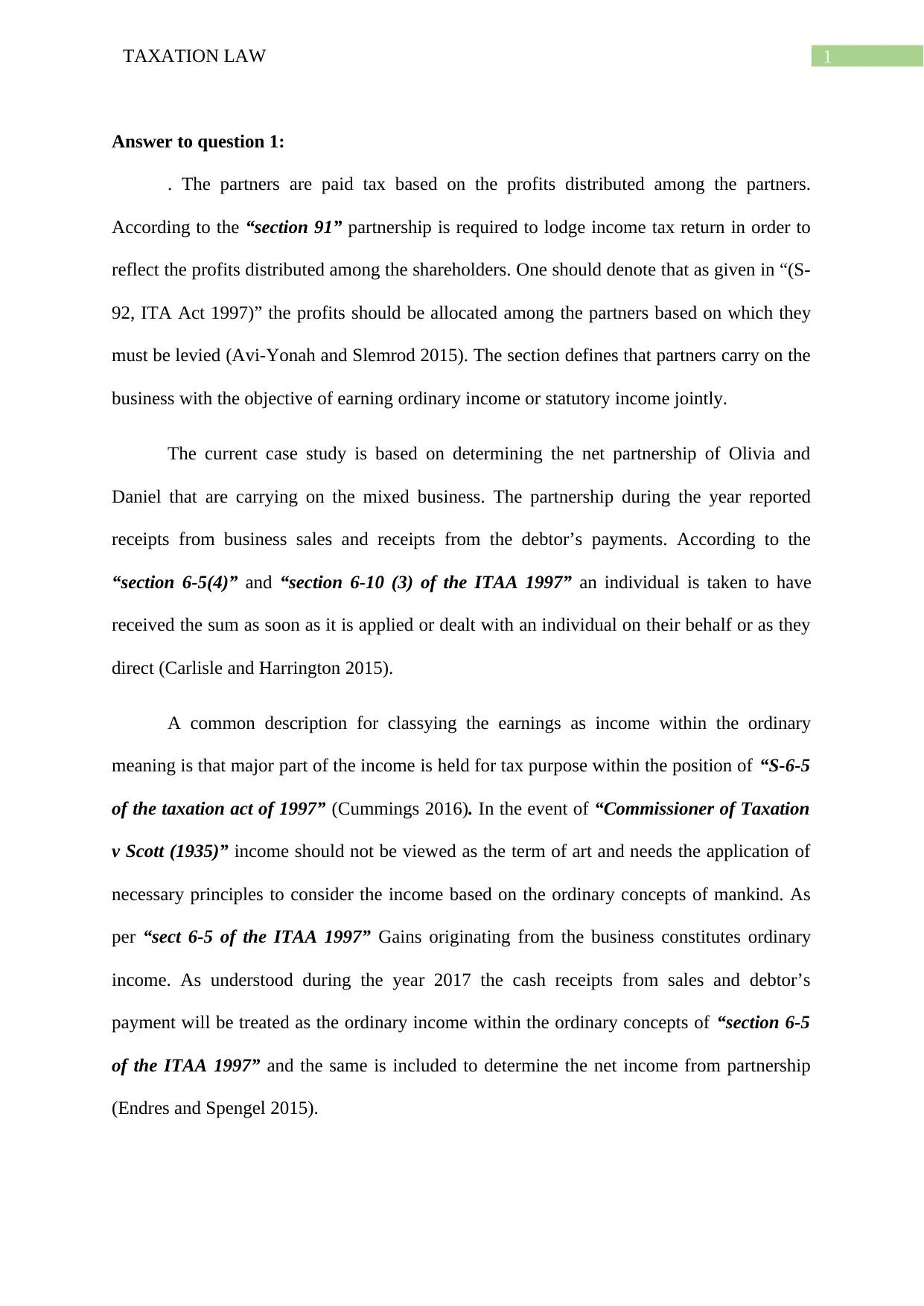
1TAXATION LAW
Answer to question 1:
. The partners are paid tax based on the profits distributed among the partners.
According to the “section 91” partnership is required to lodge income tax return in order to
reflect the profits distributed among the shareholders. One should denote that as given in “(S-
92, ITA Act 1997)” the profits should be allocated among the partners based on which they
must be levied (Avi-Yonah and Slemrod 2015). The section defines that partners carry on the
business with the objective of earning ordinary income or statutory income jointly.
The current case study is based on determining the net partnership of Olivia and
Daniel that are carrying on the mixed business. The partnership during the year reported
receipts from business sales and receipts from the debtor’s payments. According to the
“section 6-5(4)” and “section 6-10 (3) of the ITAA 1997” an individual is taken to have
received the sum as soon as it is applied or dealt with an individual on their behalf or as they
direct (Carlisle and Harrington 2015).
A common description for classying the earnings as income within the ordinary
meaning is that major part of the income is held for tax purpose within the position of “S-6-5
of the taxation act of 1997” (Cummings 2016). In the event of “Commissioner of Taxation
v Scott (1935)” income should not be viewed as the term of art and needs the application of
necessary principles to consider the income based on the ordinary concepts of mankind. As
per “sect 6-5 of the ITAA 1997” Gains originating from the business constitutes ordinary
income. As understood during the year 2017 the cash receipts from sales and debtor’s
payment will be treated as the ordinary income within the ordinary concepts of “section 6-5
of the ITAA 1997” and the same is included to determine the net income from partnership
(Endres and Spengel 2015).
Answer to question 1:
. The partners are paid tax based on the profits distributed among the partners.
According to the “section 91” partnership is required to lodge income tax return in order to
reflect the profits distributed among the shareholders. One should denote that as given in “(S-
92, ITA Act 1997)” the profits should be allocated among the partners based on which they
must be levied (Avi-Yonah and Slemrod 2015). The section defines that partners carry on the
business with the objective of earning ordinary income or statutory income jointly.
The current case study is based on determining the net partnership of Olivia and
Daniel that are carrying on the mixed business. The partnership during the year reported
receipts from business sales and receipts from the debtor’s payments. According to the
“section 6-5(4)” and “section 6-10 (3) of the ITAA 1997” an individual is taken to have
received the sum as soon as it is applied or dealt with an individual on their behalf or as they
direct (Carlisle and Harrington 2015).
A common description for classying the earnings as income within the ordinary
meaning is that major part of the income is held for tax purpose within the position of “S-6-5
of the taxation act of 1997” (Cummings 2016). In the event of “Commissioner of Taxation
v Scott (1935)” income should not be viewed as the term of art and needs the application of
necessary principles to consider the income based on the ordinary concepts of mankind. As
per “sect 6-5 of the ITAA 1997” Gains originating from the business constitutes ordinary
income. As understood during the year 2017 the cash receipts from sales and debtor’s
payment will be treated as the ordinary income within the ordinary concepts of “section 6-5
of the ITAA 1997” and the same is included to determine the net income from partnership
(Endres and Spengel 2015).
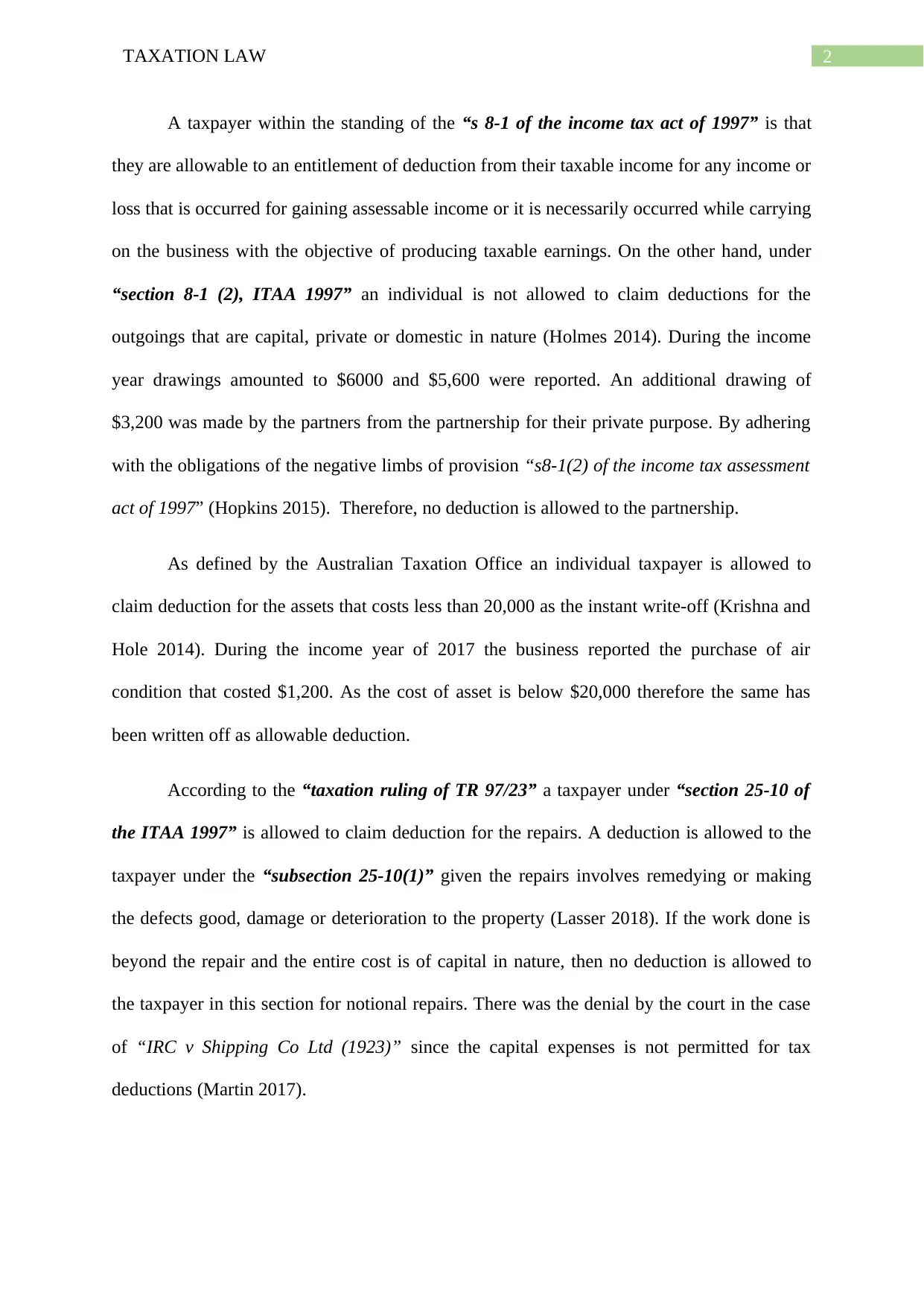
2TAXATION LAW
A taxpayer within the standing of the “s 8-1 of the income tax act of 1997” is that
they are allowable to an entitlement of deduction from their taxable income for any income or
loss that is occurred for gaining assessable income or it is necessarily occurred while carrying
on the business with the objective of producing taxable earnings. On the other hand, under
“section 8-1 (2), ITAA 1997” an individual is not allowed to claim deductions for the
outgoings that are capital, private or domestic in nature (Holmes 2014). During the income
year drawings amounted to $6000 and $5,600 were reported. An additional drawing of
$3,200 was made by the partners from the partnership for their private purpose. By adhering
with the obligations of the negative limbs of provision “s8-1(2) of the income tax assessment
act of 1997” (Hopkins 2015). Therefore, no deduction is allowed to the partnership.
As defined by the Australian Taxation Office an individual taxpayer is allowed to
claim deduction for the assets that costs less than 20,000 as the instant write-off (Krishna and
Hole 2014). During the income year of 2017 the business reported the purchase of air
condition that costed $1,200. As the cost of asset is below $20,000 therefore the same has
been written off as allowable deduction.
According to the “taxation ruling of TR 97/23” a taxpayer under “section 25-10 of
the ITAA 1997” is allowed to claim deduction for the repairs. A deduction is allowed to the
taxpayer under the “subsection 25-10(1)” given the repairs involves remedying or making
the defects good, damage or deterioration to the property (Lasser 2018). If the work done is
beyond the repair and the entire cost is of capital in nature, then no deduction is allowed to
the taxpayer in this section for notional repairs. There was the denial by the court in the case
of “IRC v Shipping Co Ltd (1923)” since the capital expenses is not permitted for tax
deductions (Martin 2017).
A taxpayer within the standing of the “s 8-1 of the income tax act of 1997” is that
they are allowable to an entitlement of deduction from their taxable income for any income or
loss that is occurred for gaining assessable income or it is necessarily occurred while carrying
on the business with the objective of producing taxable earnings. On the other hand, under
“section 8-1 (2), ITAA 1997” an individual is not allowed to claim deductions for the
outgoings that are capital, private or domestic in nature (Holmes 2014). During the income
year drawings amounted to $6000 and $5,600 were reported. An additional drawing of
$3,200 was made by the partners from the partnership for their private purpose. By adhering
with the obligations of the negative limbs of provision “s8-1(2) of the income tax assessment
act of 1997” (Hopkins 2015). Therefore, no deduction is allowed to the partnership.
As defined by the Australian Taxation Office an individual taxpayer is allowed to
claim deduction for the assets that costs less than 20,000 as the instant write-off (Krishna and
Hole 2014). During the income year of 2017 the business reported the purchase of air
condition that costed $1,200. As the cost of asset is below $20,000 therefore the same has
been written off as allowable deduction.
According to the “taxation ruling of TR 97/23” a taxpayer under “section 25-10 of
the ITAA 1997” is allowed to claim deduction for the repairs. A deduction is allowed to the
taxpayer under the “subsection 25-10(1)” given the repairs involves remedying or making
the defects good, damage or deterioration to the property (Lasser 2018). If the work done is
beyond the repair and the entire cost is of capital in nature, then no deduction is allowed to
the taxpayer in this section for notional repairs. There was the denial by the court in the case
of “IRC v Shipping Co Ltd (1923)” since the capital expenses is not permitted for tax
deductions (Martin 2017).
⊘ This is a preview!⊘
Do you want full access?
Subscribe today to unlock all pages.

Trusted by 1+ million students worldwide
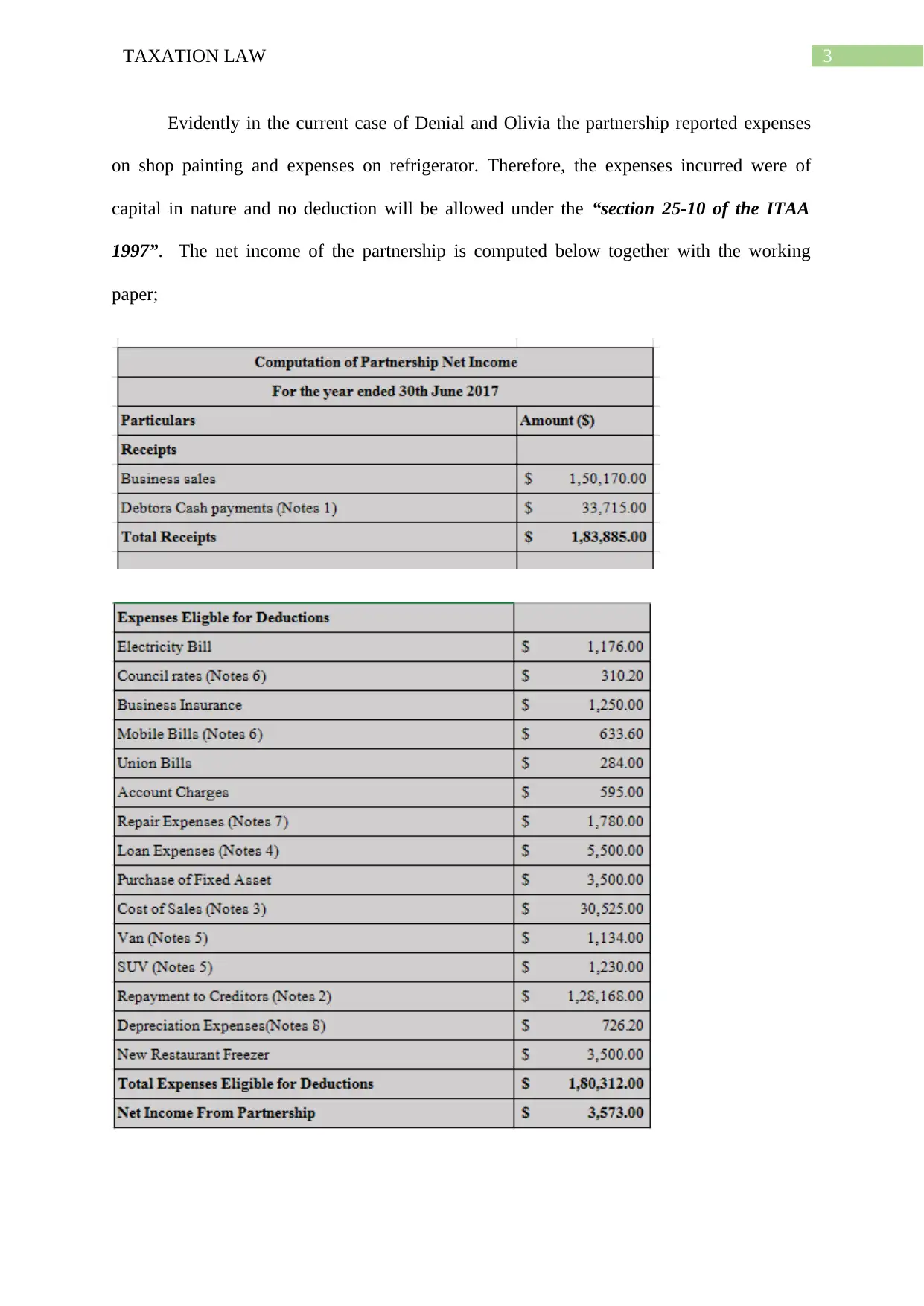
3TAXATION LAW
Evidently in the current case of Denial and Olivia the partnership reported expenses
on shop painting and expenses on refrigerator. Therefore, the expenses incurred were of
capital in nature and no deduction will be allowed under the “section 25-10 of the ITAA
1997”. The net income of the partnership is computed below together with the working
paper;
Evidently in the current case of Denial and Olivia the partnership reported expenses
on shop painting and expenses on refrigerator. Therefore, the expenses incurred were of
capital in nature and no deduction will be allowed under the “section 25-10 of the ITAA
1997”. The net income of the partnership is computed below together with the working
paper;
Paraphrase This Document
Need a fresh take? Get an instant paraphrase of this document with our AI Paraphraser
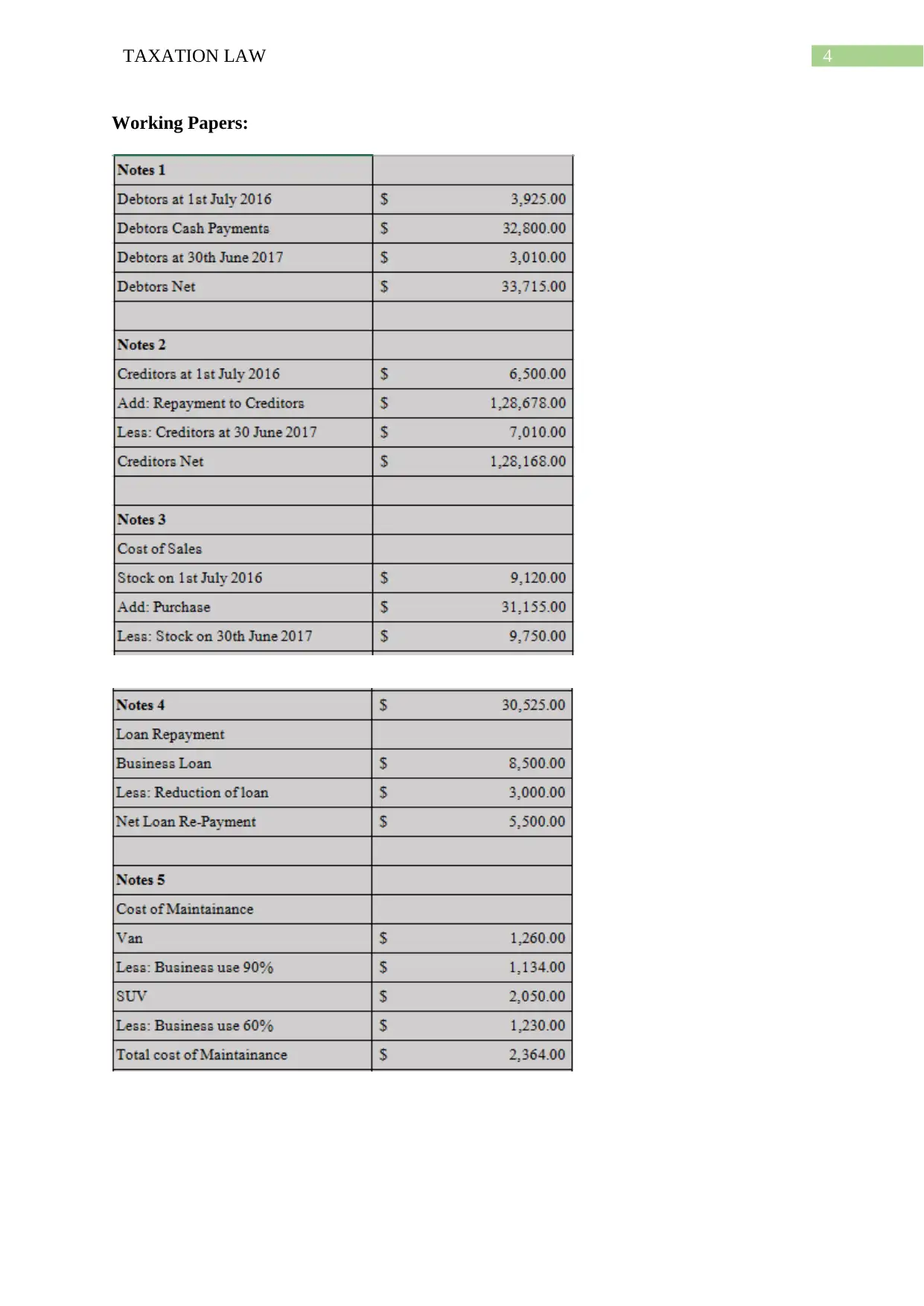
4TAXATION LAW
Working Papers:
Working Papers:

5TAXATION LAW
Answer to question 2:
When the employee is working for the corporate firm then there is certain kind of
payments that the employer gives to them but they are not in the kind of remuneration
(Okello 2014). The standing of the legislature explains that the employer gives the benefit
only when they are having the job employment with the organization.
This signifies the benefits that is offered to someone because they are employee.
There are specific conditions when the onus of making payment for tax linked with the
benefit given in the course of employment by the employer to the employee. In certain
circumstances the employer can reduce the fringe benefit tax liability given the employees
makes the payment towards the cost of providing fringe benefit (Preston 2016). The payment
Answer to question 2:
When the employee is working for the corporate firm then there is certain kind of
payments that the employer gives to them but they are not in the kind of remuneration
(Okello 2014). The standing of the legislature explains that the employer gives the benefit
only when they are having the job employment with the organization.
This signifies the benefits that is offered to someone because they are employee.
There are specific conditions when the onus of making payment for tax linked with the
benefit given in the course of employment by the employer to the employee. In certain
circumstances the employer can reduce the fringe benefit tax liability given the employees
makes the payment towards the cost of providing fringe benefit (Preston 2016). The payment
⊘ This is a preview!⊘
Do you want full access?
Subscribe today to unlock all pages.

Trusted by 1+ million students worldwide

6TAXATION LAW
is generally regarded as the employee contribution. The employer is however liable for the
taxation following the deduction of the contributions that workers or employees have made.
In this situation it is understood that the employee here is John that is working with
the organization which is engaged in the activities of printing and also his child schooling
fees is directly paid by the employer in which he is currently engaged.
It should be eminently considered by the employer benefit that are attached with the
employment such as directly reimbursing or paying the outlays to the member of staff is the
benefit of expense payment based on the legislation of “s-20, FBT Assessment act 1986”. A
disbursement would be allowed for reduction from the assessable charge of the fringe benefit
payment if the recipient of the expenditure is in relation to the full time child’s education
(Sattinger 2017). Under the “sub-paragraph 65A (ii), FBTAA 1986” there was the
noteworthy verdict has been given in “FCT v J and G Knowles (2000)” the person that
receives the benefit should be having the nexus with the benefit.
There is the confirmation which suggest that John is presently compensated by his
company with the education outlays of his child. The school fees of the child are in context of
the full time education and also possess the adequate material relation to the child’s full time
education. However, the employer of John will be allowed for reduction in the fringe benefit
tax as the expenses were incurred in relation to the full time education of the employee’s
child.
The legislative standing of “s-25, FBT Assessment Act” is that when it is noticeably
found that the member of staff is given with the house so that he can use it for
accommodation purpose and using the lodging as the over-all dwelling of house.
The explanation that is given within the legislative standing of s-25 house given as
accommodation should be viewed as employee’s usual place of residence (Sattinger 2017). It
is generally regarded as the employee contribution. The employer is however liable for the
taxation following the deduction of the contributions that workers or employees have made.
In this situation it is understood that the employee here is John that is working with
the organization which is engaged in the activities of printing and also his child schooling
fees is directly paid by the employer in which he is currently engaged.
It should be eminently considered by the employer benefit that are attached with the
employment such as directly reimbursing or paying the outlays to the member of staff is the
benefit of expense payment based on the legislation of “s-20, FBT Assessment act 1986”. A
disbursement would be allowed for reduction from the assessable charge of the fringe benefit
payment if the recipient of the expenditure is in relation to the full time child’s education
(Sattinger 2017). Under the “sub-paragraph 65A (ii), FBTAA 1986” there was the
noteworthy verdict has been given in “FCT v J and G Knowles (2000)” the person that
receives the benefit should be having the nexus with the benefit.
There is the confirmation which suggest that John is presently compensated by his
company with the education outlays of his child. The school fees of the child are in context of
the full time education and also possess the adequate material relation to the child’s full time
education. However, the employer of John will be allowed for reduction in the fringe benefit
tax as the expenses were incurred in relation to the full time education of the employee’s
child.
The legislative standing of “s-25, FBT Assessment Act” is that when it is noticeably
found that the member of staff is given with the house so that he can use it for
accommodation purpose and using the lodging as the over-all dwelling of house.
The explanation that is given within the legislative standing of s-25 house given as
accommodation should be viewed as employee’s usual place of residence (Sattinger 2017). It
Paraphrase This Document
Need a fresh take? Get an instant paraphrase of this document with our AI Paraphraser
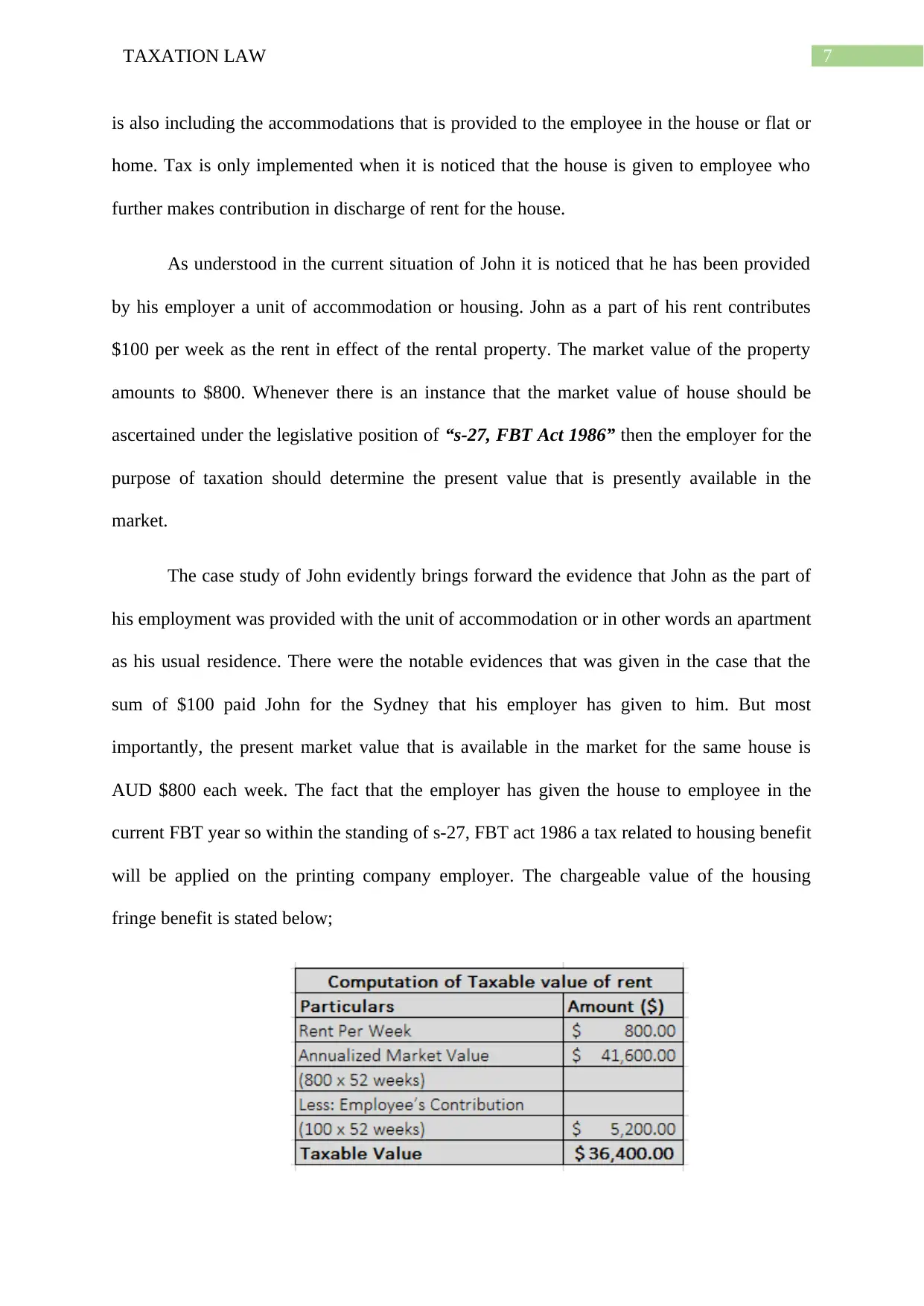
7TAXATION LAW
is also including the accommodations that is provided to the employee in the house or flat or
home. Tax is only implemented when it is noticed that the house is given to employee who
further makes contribution in discharge of rent for the house.
As understood in the current situation of John it is noticed that he has been provided
by his employer a unit of accommodation or housing. John as a part of his rent contributes
$100 per week as the rent in effect of the rental property. The market value of the property
amounts to $800. Whenever there is an instance that the market value of house should be
ascertained under the legislative position of “s-27, FBT Act 1986” then the employer for the
purpose of taxation should determine the present value that is presently available in the
market.
The case study of John evidently brings forward the evidence that John as the part of
his employment was provided with the unit of accommodation or in other words an apartment
as his usual residence. There were the notable evidences that was given in the case that the
sum of $100 paid John for the Sydney that his employer has given to him. But most
importantly, the present market value that is available in the market for the same house is
AUD $800 each week. The fact that the employer has given the house to employee in the
current FBT year so within the standing of s-27, FBT act 1986 a tax related to housing benefit
will be applied on the printing company employer. The chargeable value of the housing
fringe benefit is stated below;
is also including the accommodations that is provided to the employee in the house or flat or
home. Tax is only implemented when it is noticed that the house is given to employee who
further makes contribution in discharge of rent for the house.
As understood in the current situation of John it is noticed that he has been provided
by his employer a unit of accommodation or housing. John as a part of his rent contributes
$100 per week as the rent in effect of the rental property. The market value of the property
amounts to $800. Whenever there is an instance that the market value of house should be
ascertained under the legislative position of “s-27, FBT Act 1986” then the employer for the
purpose of taxation should determine the present value that is presently available in the
market.
The case study of John evidently brings forward the evidence that John as the part of
his employment was provided with the unit of accommodation or in other words an apartment
as his usual residence. There were the notable evidences that was given in the case that the
sum of $100 paid John for the Sydney that his employer has given to him. But most
importantly, the present market value that is available in the market for the same house is
AUD $800 each week. The fact that the employer has given the house to employee in the
current FBT year so within the standing of s-27, FBT act 1986 a tax related to housing benefit
will be applied on the printing company employer. The chargeable value of the housing
fringe benefit is stated below;
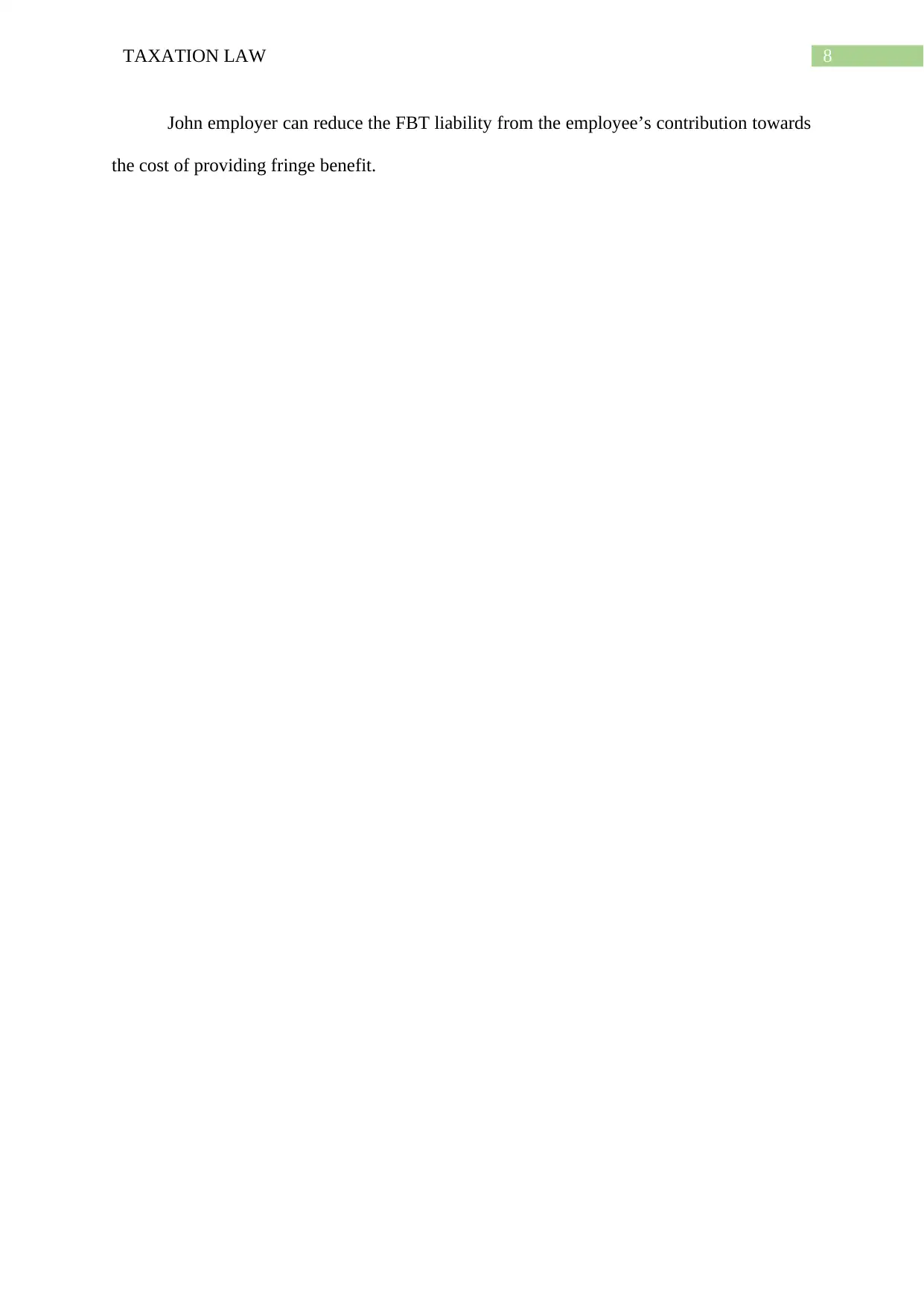
8TAXATION LAW
John employer can reduce the FBT liability from the employee’s contribution towards
the cost of providing fringe benefit.
John employer can reduce the FBT liability from the employee’s contribution towards
the cost of providing fringe benefit.
⊘ This is a preview!⊘
Do you want full access?
Subscribe today to unlock all pages.

Trusted by 1+ million students worldwide
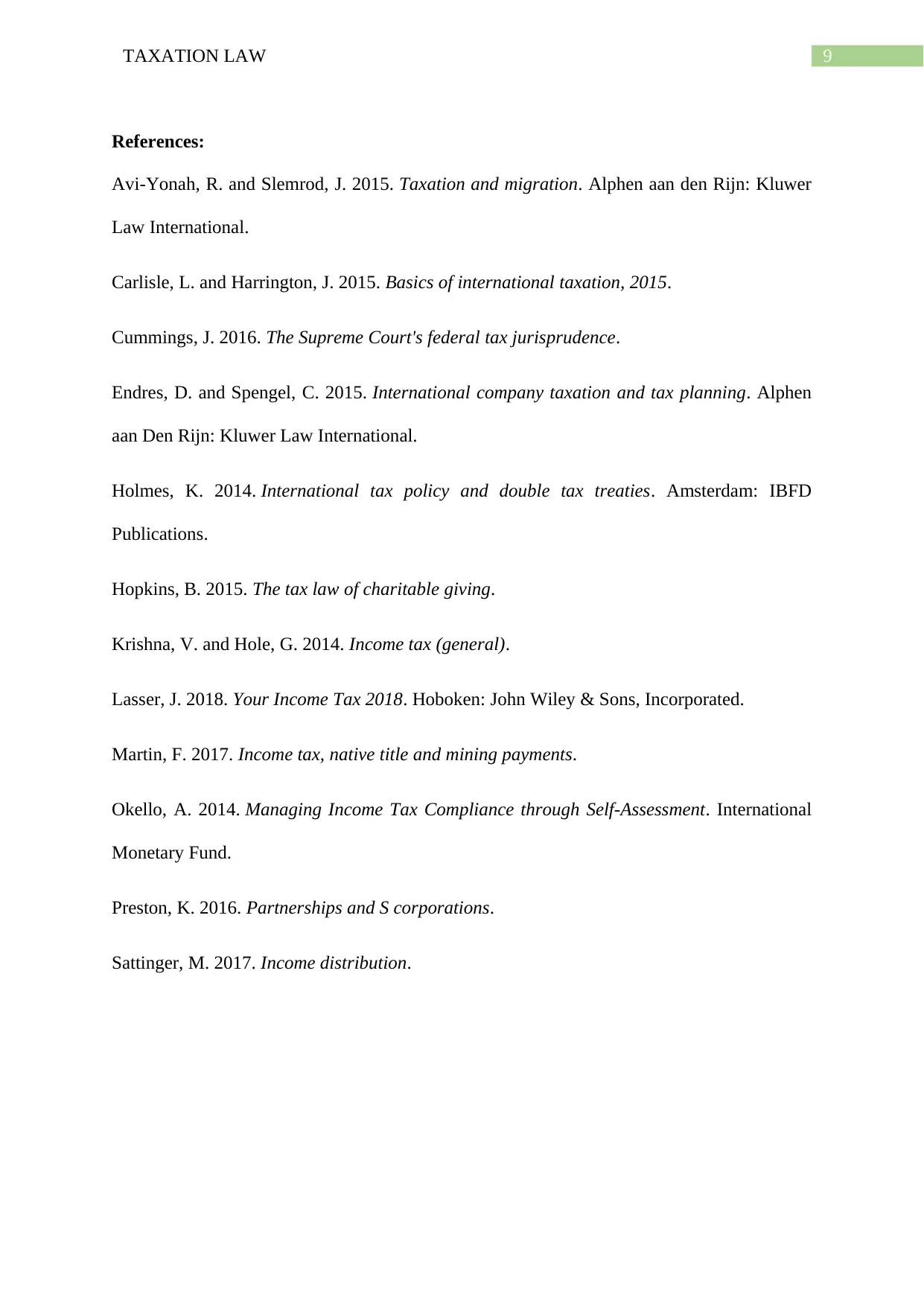
9TAXATION LAW
References:
Avi-Yonah, R. and Slemrod, J. 2015. Taxation and migration. Alphen aan den Rijn: Kluwer
Law International.
Carlisle, L. and Harrington, J. 2015. Basics of international taxation, 2015.
Cummings, J. 2016. The Supreme Court's federal tax jurisprudence.
Endres, D. and Spengel, C. 2015. International company taxation and tax planning. Alphen
aan Den Rijn: Kluwer Law International.
Holmes, K. 2014. International tax policy and double tax treaties. Amsterdam: IBFD
Publications.
Hopkins, B. 2015. The tax law of charitable giving.
Krishna, V. and Hole, G. 2014. Income tax (general).
Lasser, J. 2018. Your Income Tax 2018. Hoboken: John Wiley & Sons, Incorporated.
Martin, F. 2017. Income tax, native title and mining payments.
Okello, A. 2014. Managing Income Tax Compliance through Self-Assessment. International
Monetary Fund.
Preston, K. 2016. Partnerships and S corporations.
Sattinger, M. 2017. Income distribution.
References:
Avi-Yonah, R. and Slemrod, J. 2015. Taxation and migration. Alphen aan den Rijn: Kluwer
Law International.
Carlisle, L. and Harrington, J. 2015. Basics of international taxation, 2015.
Cummings, J. 2016. The Supreme Court's federal tax jurisprudence.
Endres, D. and Spengel, C. 2015. International company taxation and tax planning. Alphen
aan Den Rijn: Kluwer Law International.
Holmes, K. 2014. International tax policy and double tax treaties. Amsterdam: IBFD
Publications.
Hopkins, B. 2015. The tax law of charitable giving.
Krishna, V. and Hole, G. 2014. Income tax (general).
Lasser, J. 2018. Your Income Tax 2018. Hoboken: John Wiley & Sons, Incorporated.
Martin, F. 2017. Income tax, native title and mining payments.
Okello, A. 2014. Managing Income Tax Compliance through Self-Assessment. International
Monetary Fund.
Preston, K. 2016. Partnerships and S corporations.
Sattinger, M. 2017. Income distribution.
Paraphrase This Document
Need a fresh take? Get an instant paraphrase of this document with our AI Paraphraser

10TAXATION LAW
1 out of 11
Related Documents
Your All-in-One AI-Powered Toolkit for Academic Success.
+13062052269
info@desklib.com
Available 24*7 on WhatsApp / Email
![[object Object]](/_next/static/media/star-bottom.7253800d.svg)
Unlock your academic potential
Copyright © 2020–2025 A2Z Services. All Rights Reserved. Developed and managed by ZUCOL.





